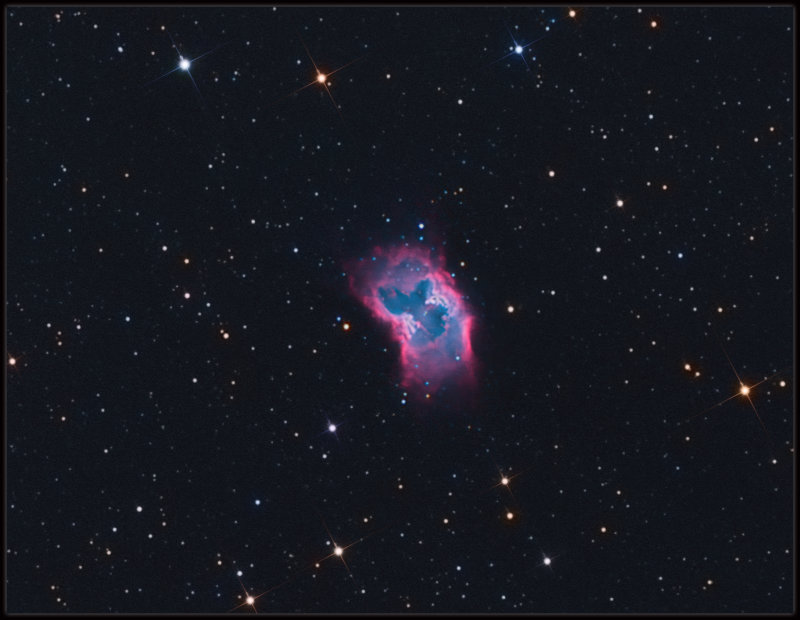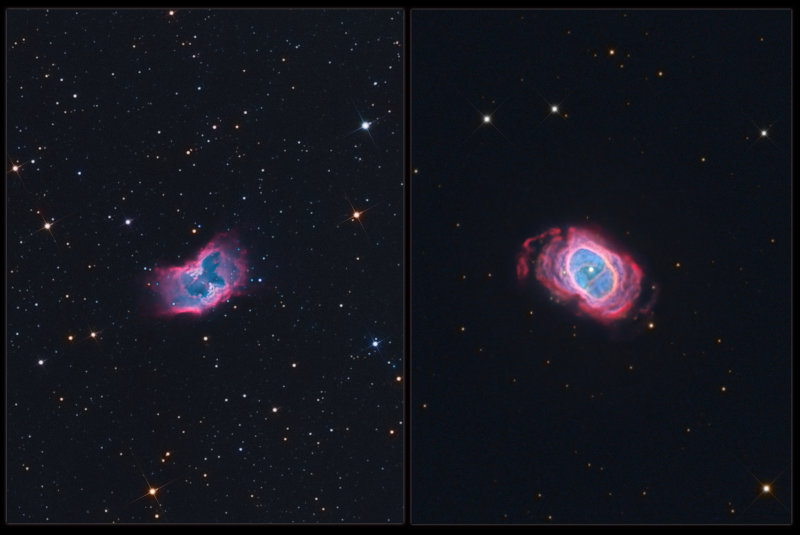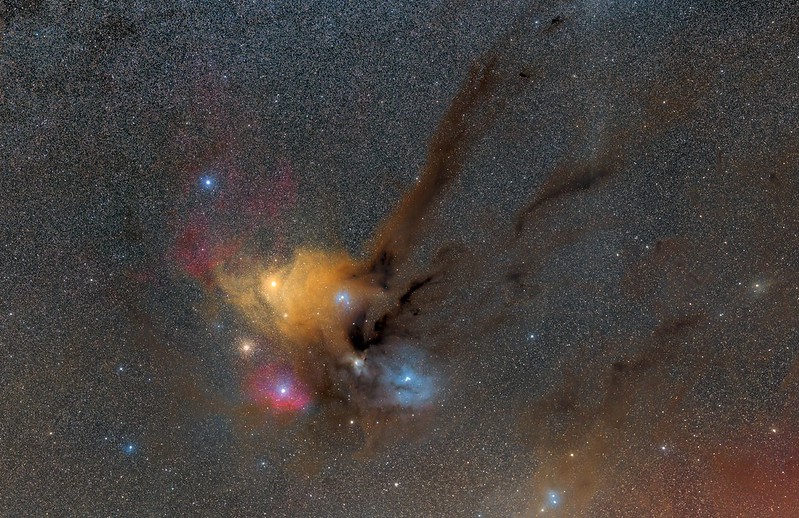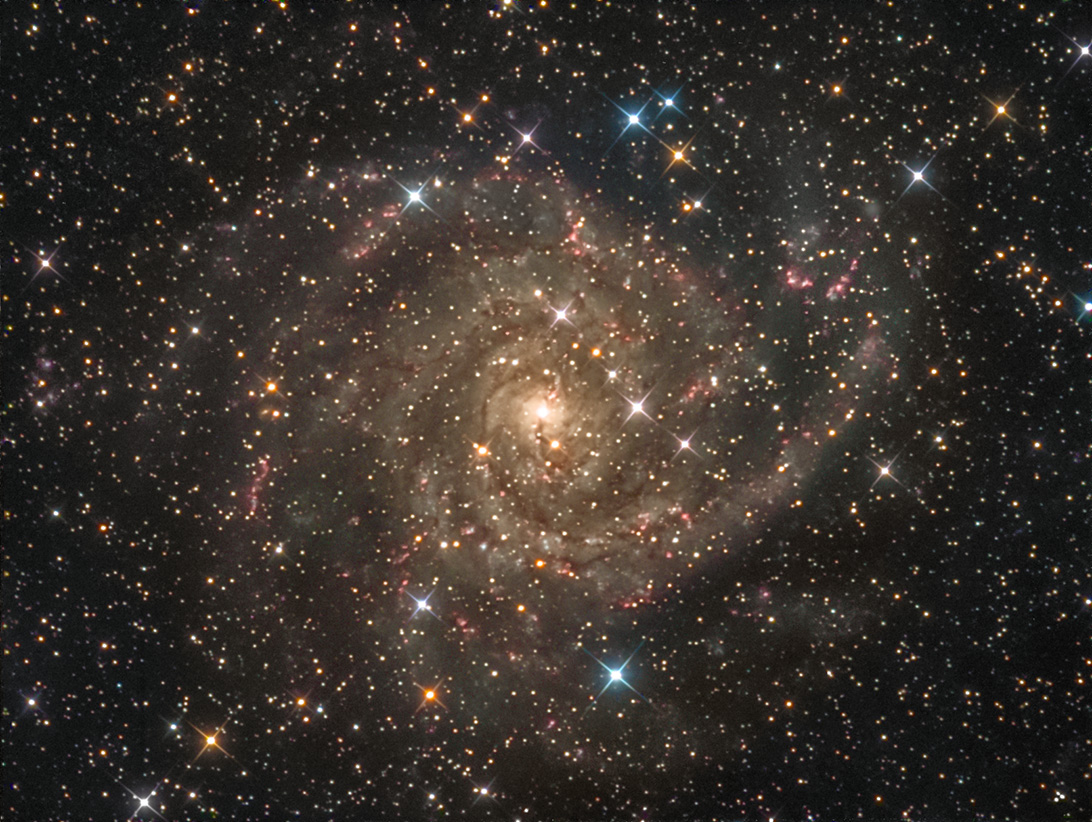Page 1 of 5
Submissions: 2019 November
Posted: Sat Nov 02, 2019 4:53 pm
by bystander
__________________________________________________________________________________________________
Please post your images here.
Please see
this thread before posting images; posting images demonstrates your agreement with
the possible uses for your image.
If hotlinking to an image, please ensure it is under 400K.
Hotlinks to images over 400K slow down the thread too much and will be disabled.
Thank you!
_________________________________________________________________________________________________
<- Previous submissions
Re: Submissions: 2019 November
Posted: Sat Nov 02, 2019 5:07 pm
by behyar
Re: Submissions: 2019 November
Posted: Sat Nov 02, 2019 7:10 pm
by LuigiF
Don't miss the next Mercury Transit
Here in Halpha and White light the last transit of Mercury of May 5th 2016
https://flic.kr/p/2hE7D9W
Copyright: Luigi Fiorentino
Re: Submissions: 2019 November
Posted: Sat Nov 02, 2019 9:24 pm
by Astrodude13
Re: Submissions: 2019 November
Posted: Sat Nov 02, 2019 9:54 pm
by Astrodude13
Re: Submissions: 2019 November
Posted: Sat Nov 02, 2019 11:59 pm
by tango33
Hi,
Two very nice Planetary nebulae closeups:
NGC 2899
Hi res and details:
https://pbase.com/tango33/image/169981890/original
NGC 3122
Hi res and details:
https://pbase.com/tango33/image/169981543/original
Thanks for looking!
Kfir Simon


And also side by side:

Re: Submissions: 2019 November
Posted: Sun Nov 03, 2019 3:08 am
by KuriousGeorge
Crab Nebula. KG Observatory. Julian, CA.
https://www.astrobin.com/1gsgfg/
My goal with this project was to expose as much as the natural color (RGB) as possible with the details present in the Ha. To that end, I used Ha as a luminance layer over the RGB. A Masked Stretch in PI helped minimize any harshness in the bright Ha areas.
I then created a starless OIII layer by subtracting Ha from OIII and layering that result over the HaRGB.
So in effect I have Ha (luminance) over RGB and then layered with (OIII - Ha) as subtle blue-green. This all helps maintain the original RGB fidelity.
Seeing during Ha capture was between 2" and 3" FWHM rather than my normal 1" to 2". Carefully deconvolution of the Ha layer followed by PI MultiscaleLinearTransform helped improve this Ha data.
"The Crab Nebula is a supernova remnant in the constellation of Taurus. The current name is due to William Parsons, 3rd Earl of Rosse, who observed the object in 1840 using a 36-inch telescope and produced a drawing that looked somewhat like a crab. Corresponding to a bright supernova recorded by Chinese astronomers in 1054, the nebula was observed later by English astronomer John Bevis in 1731. The nebula was the first astronomical object identified with a historical supernova explosion.
At an apparent magnitude of 8.4, comparable to that of Saturn's moon Titan, it is not visible to the naked eye but can be made out using binoculars under favourable conditions. The nebula lies in the Perseus Arm of the Milky Way galaxy, at a distance of about 6,500 ly from Earth. It has a diameter of 11 ly, and is expanding at a rate of about 1,500 kilometres per second (930 mi/s), or 0.5% of the speed of light.
At the center of the nebula lies the Crab Pulsar, a neutron star 28–30 kilometres (17–19 mi) across with a spin rate of 30.2 times per second, which emits pulses of radiation from gamma rays to radio waves. At X-ray and gamma ray energies above 30 keV, the Crab Nebula is generally the brightest persistent source in the sky, with measured flux extending to above 10 TeV. The nebula's radiation allows detailed study of celestial bodies that occult it. In the 1950s and 1960s, the Sun's corona was mapped from observations of the Crab Nebula's radio waves passing through it, and in 2003, the thickness of the atmosphere of Saturn's moon Titan was measured as it blocked out X-rays from the nebula."
Re: Submissions: 2019 November
Posted: Sun Nov 03, 2019 7:55 pm
by lizarranet
Milky Way nebulas wide view
From Deep Sky Chile
https://www.deepskychile.com
Copyright: Mikel Martínez
https://fotoastro.blogspot.com/
Equipment: Canon 6Dmod + Samyang 135 at f2.8 ISO 1600
 VL_NGC6334
VL_NGC6334 by
Mikel Martínez, en Flickr
Re: Submissions: 2019 November
Posted: Sun Nov 03, 2019 8:02 pm
by lizarranet
Antares and surrounding nebulas
From Deep Sky Chile
https://www.deepskychile.com
Copyright: Mikel Martínez
https://fotoastro.blogspot.com/
Equipment: Canon 6Dmod + Samyang 135 at f2.8 ISO 1600
 Rho Ophiuci nebulas
Rho Ophiuci nebulas by
Mikel Martínez, en Flickr
Re: Submissions: 2019 November
Posted: Mon Nov 04, 2019 4:59 am
by prashant_naik
Re: Submissions: 2019 November
Posted: Tue Nov 05, 2019 4:02 pm
by KuriousGeorge
Little Sombrero (NGC7814). KG Observatory. Julian, CA.
This is kind of an unplanned experiment to see what's possible to acquire during the Santa Ana wind season in CA. During this night, the wind was between 10 and 15 mph. With the high dust content in the air, seeing was between 3" and 4" FWHM, compared to my normal 1" to 2".
I was only able to acquire 45 minutes of L during this very unsteady period and a bit more RGB. Unusual for me, but nevertheless challenging and fun to process.
"NGC 7814 is a spiral galaxy about 40 million light-years away in the constellation Pegasus. The galaxy is seen edge-on from Earth. It is sometimes referred to as "the little sombrero", a miniature version of Messier 104. The star field behind NGC 7814 is known for its density of faint, remote galaxies."
https://www.astrobin.com/7xr1hv/
Re: Submissions: 2019 November
Posted: Wed Nov 06, 2019 6:10 am
by jerahian
NGC 7822 in Hubble Palette
Image was taken across 2 nights on Nov. 1 and Nov. 3, 2019 from Cape Elizabeth, Maine, using narrowband filters mapped to the Hubble Palette. Total integration time was 11.2h.
Full size image link:
https://cdn.astrobin.com/thumbs/ZsyywOD ... hqkGbg.jpg
Description
As the remnant of old massive stars which have since disappeared, Sharpless 2-171 is an expanding shell of gas and dust now illuminated and ionized by the high energy of the very hot new stars known as Berkeley 59 (the cluster right of center). The bright nebula illuminated by these stars is designated as Cederblad 214 (a.k.a. LBN 118.11+04.78), while the surrounding fainter diffuse nebula it is being blown into is designated as NGC 7822.
Just to the right of the Berkeley 59 stars, in the midst of the dark region of gas & dust, is the known radio source W1 (a.k.a. GRS G118.10 +05.00). SIMBAD associates Sh 2-171 with a supernova remnant, SNR G118.3+04.8. The dark cloud around Sh 2-171 is LDN 1271.
Thank you,
Ara
Re: Submissions: 2019 November
Posted: Wed Nov 06, 2019 3:01 pm
by donwaid
IC 342 - The Hidden Galaxy
http://www.waid-observatory.com
Copyright: Donald Waid
Web link for the image including description and equipment used.
http://www.waid-observatory.com/IC342-2019-10-31.html
(Click on the displayed images to progress to higher resolutions.)
Clear skies,
Don Waid
Re: Submissions: 2019 November
Posted: Wed Nov 06, 2019 5:18 pm
by LuigiF
LuigiF wrote: ↑Sat Nov 02, 2019 7:10 pm
Don't miss the next Mercury Transit
Here in Halpha and White light the last transit of Mercury of May 9th 2016
https://flic.kr/p/2hE7D9W
Copyright: Luigi Fiorentino
Re: Submissions: 2019 November
Posted: Thu Nov 07, 2019 2:53 am
by barretosmed
NGC 55
NGC 55. This galaxy is an irregular barred spiral and is believed to be very similar to the Great Magellanic Cloud, but turned sideways while GNM is facing us.
It is part of the sculptor's group of galaxies.
Best details:
https://www.astrobin.com/full/mbzuy4/0/?nc=user
Equipments:
Apo 150mm triplet
Qhy 16200
During the month of June and July
27 L 500 "
49 RGB 300 "
Munhoz - MG-BRAZIL
Re: Submissions: 2019 November
Posted: Thu Nov 07, 2019 7:23 pm
by Carballada
 Bubble Nebula (NGC7635) NB in SHO palette
Bubble Nebula (NGC7635) NB in SHO palette by
Jose Carballada, on Flickr
complete info at:
https://www.astrobin.com/r77l43
NGC 7635, also known as the Bubble Nebula, Sharpless 162, or Caldwell 11, is an H II region emission nebula in the constellation Cassiopeia. It lies close to the direction of the open cluster Messier 52. The "bubble" is created by the stellar wind from a massive hot, 8.7 magnitude young central star, SAO 20575.
The nebula is near a giant molecular cloud which contains the expansion of the bubble nebula while itself being excited by the hot central star, causing it to glow. (Desc creditcs: Wikipedia)
Re: Submissions: 2019 November
Posted: Thu Nov 07, 2019 7:38 pm
by MarkStiles
 HFG1
HFG1 by
Mark Stiles, on Flickr
this is my first time submitting, please tell me if i'm doing it wrong

Imaging telescope or lens:Skywatcher MN190
Imaging camera:ZWO Optical ASI183mm
Mount:Orion Atlas Pro AZ/EQ-G Atlas Pro az/eq-g
Guiding telescope or lens:Skywatcher MN190
Guiding camera:ZWO ASI120MM-S
Software:SGPRO, PHD2. PixInsight
Filters:Astronomik Ha 6nm, Astrodon E-series 2 R, Astrodon E-Series 2 3nm OIII, Astrodon E-series 2 G, Astrodon E-series 2 B
Resolution: 4580x3040
Dates:Oct. 28, 2018, Nov. 16, 2018, Nov. 17, 2018, Oct. 4, 2019, Oct. 8, 2019
Frames:
Astronomik Ha 6nm: 127x900" (gain: 178.00)
Astrodon E-Series 2 3nm OIII: 216x900" (gain: 111.00)
Astrodon E-series 2 B: 80x180" (gain: 111.00)
Astrodon E-series 2 G: 76x180" (gain: 111.00)
Astrodon E-series 2 R: 80x180" (gain: 111.00)
Integration: 97.5 hours
Pixel scale: 0.495 arcsec/pixel
Re: Submissions: 2019 November
Posted: Thu Nov 07, 2019 9:35 pm
by Ann
MarkStiles wrote: ↑Thu Nov 07, 2019 7:38 pm
 HFG1
HFG1 by
Mark Stiles, on Flickr
this is my first time submitting, please tell me if i'm doing it wrong

Imaging telescope or lens:Skywatcher MN190
Imaging camera:ZWO Optical ASI183mm
Mount:Orion Atlas Pro AZ/EQ-G Atlas Pro az/eq-g
Guiding telescope or lens:Skywatcher MN190
Guiding camera:ZWO ASI120MM-S
Software:SGPRO, PHD2. PixInsight
Filters:Astronomik Ha 6nm, Astrodon E-series 2 R, Astrodon E-Series 2 3nm OIII, Astrodon E-series 2 G, Astrodon E-series 2 B
Resolution: 4580x3040
Dates:Oct. 28, 2018, Nov. 16, 2018, Nov. 17, 2018, Oct. 4, 2019, Oct. 8, 2019
Frames:
Astronomik Ha 6nm: 127x900" (gain: 178.00)
Astrodon E-Series 2 3nm OIII: 216x900" (gain: 111.00)
Astrodon E-series 2 B: 80x180" (gain: 111.00)
Astrodon E-series 2 G: 76x180" (gain: 111.00)
Astrodon E-series 2 R: 80x180" (gain: 111.00)
Integration: 97.5 hours
Pixel scale: 0.495 arcsec/pixel
Nice picture, Mark! Welcome to Starship Asterisk*!

Ann
Re: Submissions: 2019 November
Posted: Thu Nov 07, 2019 10:01 pm
by MarkStiles
Thank you Ann! i'm a little lost

Re: Submissions: 2019 November
Posted: Fri Nov 08, 2019 5:34 pm
by PatrickWinkler
The Horse Head Nebula
Posted: Fri Nov 08, 2019 6:26 pm
by Efrain Morales
Orion's The Flame Nebula (NGC2024), The Star Anitak and The Horse Head nebula (B33). (Equipment: ES ED80APO, CGE Mount, ST2000xm Ccd, AO8, CF9, Astronomik Ha, LRGB filter set.)
Re: Submissions: 2019 November
Posted: Fri Nov 08, 2019 10:07 pm
by vikassahota
im new here, hope this is Ok!

Andromeda M13
Captured in LRGB using the Hypercam 183m mono camera, Baader 2" filters, LPRO Max LP filter, and the Altair 72EDF scope. Its a total of 24.3 hrs of capture time occuring between end sept and all through october. Location is Slough, UK. The individual channels were treated for light pollultion and then combined. They are expsoures mostly of 10mins, so the stars were quite bloated. It went through a process of star removal and cleanup , then the original with lesser stretch was used to recreate the background stars. The 'foreground' stars in front of andromeda have been removed more or less - the aim of leaving behind the stars that looked like they could belong on the target rather than the foreground. its kind of wiping away the stars between us and andromeda for a nice view down the middle. if we knew distances to all the stars and could run some clever filter that would have been quicker and easier to do for sure:)
hope you like it!
Vik
Re: Submissions: 2019 November
Posted: Sat Nov 09, 2019 1:41 pm
by Goudig
From Zeta Ophiuchi to Corona Australis
https://www.bastienfoucher.com
Copyright: Bastien Foucher
Finally, the end of a big mosaic project... 37 tiles and more than 38 hours of total exposure time, 230 mega pixels. The pictures were taken under the very dark skies of Chile (2016, 2018) and Namibia (2019). 3 constellations are covered : Scorpius, Sagittarius and Corona Australis. See the annotated zoomable picture in the links below.
In higher resolution :
https://photos.smugmug.com/Astrophotogr ... Center.jpg
For the whole story, the very high resolution zoomable and annotated image, please click here :
http://www.astrosurf.com/bastienfoucher ... ex_en.html
An extract of the main picture, showing Zeta Ophiuchi star and the Milky Way center :
In higher resolution :
https://photos.smugmug.com/Astrophotogr ... lbe-X4.jpg
Thank you.
Bastien
Re: Submissions: 2019 November
Posted: Sat Nov 09, 2019 3:13 pm
by Ann
Absolutely fantastic images, Bastien! I particularly like the one where the little Corona Australis star forming region is peeking out near the bottom of the image, totally dwarfed by the glory of Scorpius, but still there in its own right!
Ann
Re: Submissions: 2019 November
Posted: Sat Nov 09, 2019 5:27 pm
by markh@tds.net
Hubble's Variable Nebula - NGC 2261
Copyright Mark Hanson
Description by "Sakib Rasool"
"Like a cosmic flower, Hubble's Variable Nebula is a lovely reflection that appears to sprout from the bright star R Monocerotis. Otherwise catalogued as NGC 2261 by the astronomer John Louis Emil Dreyer in 1888 in his iconic New General Catalogue, this nebula was discovered in 1783 by William Herschel. It is also famous for the being the first deep sky object to have been photographed with the Hale Telescope at the Palomar Observatory in 1949 by none other than Edwin Hubble.
The popular name of this nebula arises from it being studied by Edwin Hubble in 1916 who noticed it changed in brightness. It is now known that its dramatic and quite quick changes in brightness and appearance are the result of opaque clouds of dust situated between the star and the nebula. The appearance of NGC 2261 has been observed to change on timescales of a few months if not a few days!
The reddish nebulosity visible to the north of NGC 2261 is an example of a Herbig Haro object, a type of jet ejected by a young star that glows by the energy generated by the gas colliding with its surrounding space. They were originally independently discovered by the astronomers George Herbig and Guillermo Haro. This Herbig Haro object is catalogued as HH 39 and more than a thousand are currently known. An analysis of the proper motion of the knots in HH 39 show that it is moving away from R Monocerotis and NGC 2261."
LRGBHa 300,180,180,180,450 Taken with a PlaneWave 24" CDK from Animas New Mexico.
You can see the higher Resolution images here :
https://www.hansonastronomy.com/hubble-veriable-nebula
Thank you,
Mark Hanson














